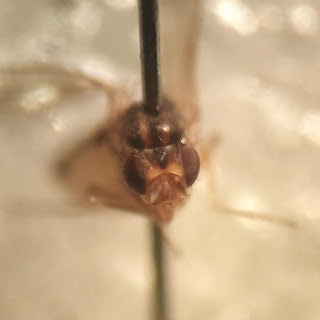I went for a walk round Ebernoe Common the weekend before last, on one of those hot sunny days that seem like a distant memory after a few days of rain.
It had been so dry, I was surprised to find a fallen beech tree sprouting oyster mushrooms: Pleurotus ostreatus, I believe. On the southern side of the trunk they were fully grown and showing signs of having been grazed upon by molluscs.
A very active Black-headed Cardinal Beetle Pyrochroa coccinea seemed to be investigating the area. Perhaps looking for smaller insects to prey upon.
On the northern side of the trunk, more fruit bodies were emerging in their hundreds from underneath the bark.
Approaching, I scared up a great cloud of insects which, left undisturbed for a few minutes, settled again on the fresh young fruit bodies.
Looking closely, I saw that most of these insects were tiny flies.
I asked Sussex dipterist Patrick Roper if he could tell me anything about these flies and was delighted when – looking at a photograph – he tentatively identified them as fruit fly Hirtodrosophila trivittata.
I needed to get one of these flies under the microscope to get a proper look at its features, so returned to Ebernoe a few days later to collect a specimen. The dark stripes on the thorax, with the central stripe extending down the top of the head is really quite distinctive. And it's got this little black 'spoiler' type structure on the back of the thorax which must give it some mad aerodynamic properties.
Patrick's identification was confirmed by Peter Chandler in the Dipterists Forum who was kind enough to share an account of this species. It was first recorded in England in 2008, from Hampshire, but has since occurred widely in the south, usually in association with Pleurotus species, "around which it can be quite numerous". That was certainly the case where I found it!
I think this sighting may constitute the second record for Sussex, as it was apparently recorded from Fontwell Wood in 2011. But it's hard to be sure as the species doesn't seem to have made it into the UK species dictionary yet, or iRecord.
While I was distracted by the flies, my companion on this expedition, Lois Mayhew, was busy trying to get a snap of this micromoth.
Since the publication of Sterling & Parson's Field Guide to Micromoths, illustrated by Richard Lewington, micromoths are not quite as impossibly hard as they used to be. Lois identified this one as Triaxomera fulvimitrella and the UK Moths website records that "this woodland species flies from May to July when it may be found at rest on tree trunks. The larvae feed from September during the winter months in dead wood, or on bracket fungus, especially those growing on beech (Fagus) or oak (Quercus)." Another fungivore!
While Lois was appreciating the resident moth, I found yet more fruit bodies, at an earlier stage of development, emerging from the dim and sheltered underside of the fallen trunk.
A crop like this must be a great resource for the fungivorous creatures of Ebernoe Common, and their predators and parasites. I would love to know more about how these fungus-based food webs work – if anyone can point me in the direction of relevant studies.
Oh and we found a Lesser Stag Beetle Dorcus parallelipipedus here too. But I'm less interested in that because it doesn't have anything to do with fungus. Or at least I don't think it does?
For the record
Date: 1/6/2019 and 5/6/2019
Location: Ebernoe Common, West Sussex
Grid ref: SU972266
Invertebrate records submitted to Dipterists Forum / iRecord










No comments:
Post a Comment